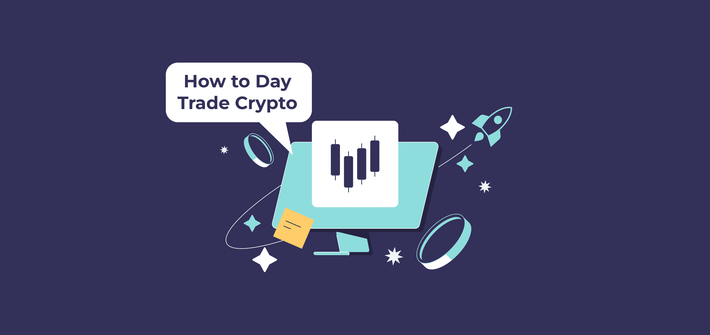How to Day Trade Crypto: Strategies, Tools & Beginner Tips
Day trading crypto is one of the most exciting, but also riskiest, ways to trade digital assets. Unlike long-term investing (HODLing), where you buy and hold through cycles, day trading focuses on capitalizing on short-term volatility seeking profits from intraday volatility.
It sounds simple on paper, but in practice, it’s anything but easy. It’s estimated that between 70% to 97% of day traders lose money. Not because they lack intelligence, but because they underestimate what this style of trading really takes.
So, from the onset, it’s important to note that this is not a pastime. It’s focus, timing, discipline, pressure, , and yes, the allure of profits that can feel intoxicating. Done right, it can sharpen you.. Done wrong, it can quickly unravel your capital.
This guide will walk you through how to day trade crypto. The tools, the strategies, and the mindset that separates short-lived day traders from long-term day traders.
Key takeaways
- Crypto day trading is an aggressive, short-term strategy where traders try to profit out of the small, rapid price swings of digital assets.
- Time commitment for day trading is high; you must constantly be screen-watching and making fast moves.
- Not all coins are suitable. You want liquid, volatile assets. The ones that actually move.
- Day trading isn’t one-size-fits-all. Different traders use different playbooks depending on their risk tolerance, time horizon, and trading style.
What is crypto day trading?
Crypto day trading is a high-risk, short-term strategy where traders try to fromthe small, rapid price swings of digital assets, Bitcoin, Ethereum, or the altcoin flavor of the day, all within the same 24-hour window.
The idea is simple: don’t wait years for a bull market. Instead,spot a setup, take your trade, and exit before the market shifts again. When day trading crypto, positions are never held overnight, which protects traders from the sudden unpredictable price moves that can hit when they’re asleep (what traditional finance calls “gap risk”).
The goal isn’t one home-run trade; it’s stacking smaller, consistent wins that add up over time.
This is the opposite of the “HODL” approach, where investors buy and sit tight for years. To really understand day trading, it helps to put it side by side with long-term investing:
| Feature | Day trading | HODLing |
| Time commitment | High – constant screen-watching, fast moves. | Low – occasional check-ins, rebalance when needed. |
| Primary goal | Short-term gains from intraday volatility. | Long-term appreciation over years or decades. |
| Risk profile | Very high – leverage, speed, and wild swings. | Lower–risk spread over time. |
| Core strategy | Technical analysis: charts, indicators, patterns. | Fundamental analysis: project strength, adoption, roadmap. |
| Holding period | Seconds, minutes, hours, but never overnight. | Months, years, or more. |
| Emotional demand | Extreme – discipline, speed, zero hesitation. | Moderate – patience and the ability to ignore daily noise. |
A step-by-step process on how to day trade crypto
1. Choose a reliable trading platform
Here’s what to look for:
- Liquidity & Volume: Without it, you can’t enter or exit trades fast enough. Check fundamentals such as 24-hour trading volume, and average liquidity. An excellent tool for tracking this is the CMC indicator.
- Security: Two-factor authentication (2FA), cold storage, and a proven track record are non-negotiable.
- Fees: Day traders rack up lots of transactions. Watch for high fees.
- Tools: You need solid charting, advanced order types (like stop-loss), and a trading engine that doesn’t freeze when the market moves.
2. Select your crypto assets
Not all coins are worth your time or risk. You want liquid, volatile assets.
- Go major: Stick to BTC and ETH. They have the tightest spreads and deepest liquidity.
- Use Stablecoin pairs: Trade against USDT or USDC. It keeps profit/loss calculations simple. (e.g., BTC/USDT).
3. Set your budget
This is where many new traders run into trouble. Rule one: never trade with money you can’t afford to lose. Only allocate capital that, if lost, would not cause significant financial harm.. So do the following:
- Define your trading capital: A separate pot of money strictly for trading.
- Per-trade risk: Follow the 1% rule (more importantly when you are a beginner). Never risk more than 1% of your trading capital on one move. For example: $5,000 bankroll = $50 max loss per trade.
4. Learn technical analysis
Fundamentals move markets long-term; charts decide what happens within minutes.
- Candlesticks: Each one shows a battle. Open, close, high, low. Learn to read them.
- Support and resistance: The market’s invisible walls. Entry and exit points live here.
- Some vital Indicators to master include: MAs (Moving averages), trend direction, RSI: tells you when things are overheated (above 70) or oversold (below 30) and MACD: Momentum shifts and potential reversals.
Learn more about Technical analysis including application of some of these indicators in our academy.
5. Build a trading plan (Goals, stops, and targets)
Every trade needs a map before you enter the market. Without it, emotion takes over and emotional trading often leads to poor outcomes.
- Stop-Loss (SL): Your shield. Set it where your predefined risk (e.g. 1% of your trading capital)ends.
- Take-Profit (TP): Define your exit point in advance. This could be set near a known resistance level or based on a risk-to-reward ratio, such as 1:2 or 1:3, to ensure your potential gains outweigh your losses.
- OCO Orders: Use One-Cancels-the-Other orders so SL and TP are in place the moment you enter.
6. Start small (Practice and paper trade)
Don’t try to conquer the market with your full bankroll on day one. Always remember that markets offer no assurances and they can stay irrational longer than you can stay solvent. As a beginner,
- Start small: Use a fraction of your capital to test your edge. As a rule of thumb, follow the 1% rule explained earlier.
- Paper trade: If your platform offers a demo account, use it. Same data, no real money. This way you get to put into practice your theoretical knowledge.
7. Stay disciplined and review regularly
Discipline is what separates gamblers from traders.
- Follow your trading plan: Don’t drag stop-losses lower. Don’t hold winners too long. Stick to the script.
- Journal every trade: Note entry, exit, reason, result. Over time, patterns emerge. So do your strengths and weaknesses.
- Stay informed: One tweet can shift momentum. Be aware of major news and economic events.
What are some popular crypto day trading strategies?
Day trading isn’t one-size-fits-all. Successful traders choose strategies that align with their risk tolerance, time horizon, and trading style. Here are some of the most common strategies, each with a real-world example.
1.Scalping
Scalpers playbook: Go for speed. Scalpers thrive on tiny, rapid moves. Think seconds or minutes, not hours.
Example: Ethereum (ETH) is bouncing between $3,100 and $3,105 on a 1-minute chart. A scalper grabs 5 ETH at $3,101 and flips it at $3,104 a few minutes later, netting $15 before fees. It’s small, but repeated dozens of times a day and those little wins compound.
2. Range trading
Range traders' playbook: Buy low, sell high, literally. Range traders work the edges of sideways markets.
Example: Bitcoin (BTC) keeps ping-ponging between $60,000 (support) and $62,000 (resistance). A trader places a buy order around $60,100, then a sell order near $61,900. When BTC bounces, both orders fill, and the trader pockets profit from the chop instead of waiting for a breakout.
3. Breakout trading
Breakout trading playbook: Wait for the market to make a decisive move, then ride the momentum.
Example: Solana (SOL) is stuck under $150 for a week. A breakout trader sets a buy-stop at $151, just above resistance. When heavy volume finally pushes SOL through $150, the order triggers, and the trader rides the breakout toward $160 (or wherever momentum carries).
4. Momentum trading
Momentum trading playbook: Jump on strong trends and don’t fight the wave.
Example: Polygon (MATIC) spikes after a big product announcement. Volume jumps, social media is buzzing, and price blasts through its 20-period MA. A momentum trader hops in, holding as long as higher highs and higher lows keep printing. When RSI shoots above 70 (flashing “overbought”), they lock in profits before the wave fizzles.
5. Arbitrage (Advanced)
Arbitrage playbook: Exploit inefficiencies. Same coin, different price, different exchange.
Example: Litecoin (LTC) is trading at $70.00 on Exchange A and $70.30 on Exchange B. A trader with pre-funded accounts buys 100 LTC on A and sells 100 LTC on B simultaneously. Just like that, they bank a quick $30 profit (before fees). Not glamorous, but nearly risk-free if done right.
What are the tools and resources for crypto day trading?
If you’re serious about day trading crypto, the right toolkit is a necessity. You need to spot setups fast, stay plugged into breaking news, and practice effectively. Here’s what that looks like.
Charting tools
Effective trading begins with strong technical analysis, and that means going beyond raw price data. You need visual tools that help you interpret market behavior—candlestick patterns, support and resistance zones, trend lines, and more.
While most exchanges offer basic charting features, professional traders often use dedicated platforms like TabTrader, which provide access to a wide range of technical indicators, customizable layouts, and advanced drawing tools, all in a single interface.
Pro tip: Once you start using a full-featured charting platform, it’s hard to go back to the limited views most exchanges offer.
Explore charting fundamentals in our Academy: Charting.
Market news sources
Charts tell you what has happened. The news tells you what’s about to happen. A regulatory headline, a token launch, or even a stray tweet can send the market into a frenzy. To keep up, traders lean on outlets like CoinDesk, The Block, and CoinTelegraph, plus the constant chatter on X (formerly Twitter).
The rule of thumb: if you’re finding out about news from your friend’s group chat, you’re already too late.
Demo accounts (Paper trading)
Before you commit real capital , practice with a demo account. Many platforms offer “paper trading”which allows you to simulate live trades using virtual funds in real market conditions. This helps new traders test strategies, build discipline, and learn platform mechanics without risking real money. . Once you can follow your own trading plan in demo mode, then you’re ready to scale up with actual capital.
What are the risks of day trading crypto?
Day trading crypto looks glamorous from the outside: quick wins, fast markets, constant action. But beneath the hype, it’s one of the riskiest ways to approach the market. it requires discipline, skill, and a clear understanding of the potential downsides. Failing to respect these risks can lead to rapid losses.
1. High volatility
Crypto is built on volatility. It’s what makes day trading even possible. But that same volatility can flip from opportunity to disaster in seconds. A candle can wipe out hours of gains in under a minute. Unlike traditional markets, there are no circuit breakers to slow things down. News, rumors, or even a single whale’s sell order can move the market violently. If you’re trading off 1-minute or 5-minute charts, you’re stepping into the eye of the storm.
2. Emotional trading
Markets don’t just test your strategy; they test your psychology. Fear and greed are ever present and both can be costly. . Greed makes you over-leverage, chase breakouts that are already gone, or hold winners too long. Fear can cause premature exits or panic-selling at the worst possible time.
The truth is, most blown accounts don’t die from bad analysis; they die from bad impulses.
3. Loss potential
Day trading means lots of trades, and every trade is another chance to get it wrong. Even a strategy that wins more often than it loses can hit a cold streak. Add leverage into the mix, and those losses multiply fast. Warren Buffet famously compared day trading to Gambling, and it is not difficult to see why.
Without hard stop losses and strict position sizing, a handful of bad moves can erase weeks of steady progress. In day trading, it’s not the big home runs that matter. It’s surviving the grind.
4. Fees
Even if you win trades, your profits aren’t yours until the hidden costs are paid. Trading fees add up shockingly fast when you’re entering and exiting multiple times a day, especially on-chain, where gas costs can spike.
Additionally, tax obligations must be considered. In many jurisdictions, every profitable trade is a taxable event. Without detailed record-keeping, traders risk facing unexpected tax liabilities at the end of the year potentially turning what looked like a successful trading year into a net financial loss.
Getting started with crypto day trading on TabTrader
If you’re dipping your toes into crypto day trading, TabTrader is one of those apps that makes life a whole lot easier. Instead of juggling ten exchange tabs and clunky charting tools, you get everything in one streamlined terminal, on your phone or desktop.
Here’s how to get started in minutes:
- Download the TabTrader app and join a global network of traders who don’t miss a beat through instant alerts, advanced charting tools and indicators, easy account management, customizable interface, and access to the 20 leading exchanges.
- Getting started is simple::
- On Android: Open the Google Play Store and search for "TabTrader".
- On iOS: Open theApp Store and search for "TabTrader”.
- On desktop: Go to app.tabtrader.com to start trading right away.
- Next, create an account using the following process:
- Enter your email.
- Create a strong password.
- Set up two-factor authentication for enhanced security.
- Enable price alerts to get push notifications to never miss a trading opportunity.
FAQs
1. What’s the minimum capital I need to start?
Technically, you can open trades with as little as $10 on some exchanges. Realistically, though, most new traders start with around $100–$500. That range gives you enough room to size positions sensibly, test strategies, and absorb trading fees without putting your whole bankroll at risk.
2. Can I day trade on TabTrader?
Absolutely. TabTrader connects directly to 20+ top exchanges like Binance, Kraken, and KuCoin. Once your accounts are linked, you can trade using your existing balances. No transfers needed. It’s built for fast execution, which is exactly what day traders depend on.
3. How much time does day trading take each day?
The crypto market never sleeps, but you don’t need to stare at charts 24/7. Many full-time traders spend 2–6 hours during peak liquidity (when US and European sessions overlap). If you’re short on time, or still learning how to day trade, cryptoTabTrader’s custom price alerts help you step away from the screen and only jump in when your setup is ready.
4. Which coins are best for beginners?
When crypto day trading, start simple with Bitcoin (BTC) and Ethereum (ETH). Both are highly liquid, with tight spreads and steady volume. Exactly what you want for smooth, reliable entries and exits.
Important note: These materials are for general informational purposes only and do not constitute financial, investment, or professional advice. Cryptocurrency investments involve significant risks, including potential substantial financial loss, and we do not endorse specific investments, tokens, or projects. Always conduct your own research and consult qualified financial or legal professionals before investing, as TabTrader disclaims liability for any losses arising from reliance on these materials to the fullest extent permitted by law.




